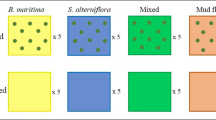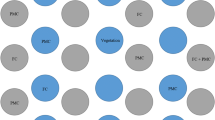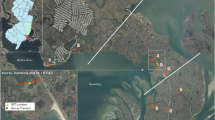Abstract
New England has an extensive history in restricting salt marsh tidal flooding to promote agricultural, industrial, and environmental endeavors. While previous research has focused on the physical and biological impacts of large-scale tidal restrictions, such as dikes and undersized culverts, the effect of smaller historic earthen barriers (average height = 0.71 m ± 0.12 SE; average length = 166 m ± 41 SE), or berms, is less understood. Here, we investigate how salt marsh plant communities respond to berms located in the interior of the marsh and oriented parallel to tidal rivers or creeks. Based on the observations from a descriptive study, the landward side of the berm consistently shows a distinct plant species assemblage from the reference areas (ANOSIM: R = 0.541, p = 0.001), which is most likely a result of landward pool development. A follow-up manipulative transplant experiment considers how the landward pools affect the governing factors (e.g., physical stress, competition, etc.) controlling the distribution and abundance of Schoenoplectus maritimus and Spartina patens in the landward and seaward zones. The experimental results show that while physical stress seems to prevent robust S. patens growth in the landward zone (ANOVA: F = 24.697; p < 0.001), herbivory seems to be the main driving factor behind the low S. maritimus cover found in the seaward zone (Mann–Whitney: U = 56, p = 0.015). The combined results from the two studies show that berm-associated pools have the potential to impact biological interactions within and across trophic levels in salt marshes.







Similar content being viewed by others
References
Amsberry L, Baker MA, Ewanchuk PJ, Bertness MD (2000) Clonal integration and the expansion of Phragmites australis. Ecol Appl 10(4):1110–1118
Anisfeld SC, Benoit G (1997) Impacts of flow restrictions on salt marshes: an instance of acidification. Environ Sci Technol 31(6):1650–1657
Anonymous (1988) Sawyer Woolen Mills. Heritage Walking Tour Report. Dover, N.H.
Argow BA, FitzGerald DM (2006) Winter processes on northern salt marshes: evaluating the impact of in situ peat compaction due to ice loading, Wells, ME. Estuar Coast Shelf Sci 69(3–4):360–369. doi:10.1016/j.ecss.2006.05.006
Armstrong J, Armstrong W (1988) Phragmites australis: a preliminary study of soil-oxidizing sites and internal gas-transport pathways. New Phytol 108(4):373–382
Bandyopadhyay BK, Pezeshki SR, Delaune RD, Lindau CW (1993) Influence of soil oxidation–reduction potential and salinity on nutrition, N-15 uptake, and growth of Spartina patens. Wetlands 13(1):10–15
Bart D, Burdick D, Chambers R, Hartman JM (2006) Human facilitation of Phragmites australis invasions in tidal marshes: a review and synthesis. Wetl Ecol Manag 14:53–65
Belknap DF, Smith DC, Gehrels WR (1997) Environmental changes in the Wells National Estuarine Research Reserve and Pemaquid Beach salt marshes, Maine, during the past 300 years: implications for restoration of New England-Type salt marshes. National Oceanic and Atmospheric Administration (NOAA)
Bertness MD (1991) Interspecific interactions among high marsh perennials in a New England salt marsh. Ecology 72(1):125–137
Bertness MD, Ellison AM (1987) Determinants of pattern in a New England salt marsh plant community. Ecol Monogr 57(2):129–147
Bertness MD, Shumway SW (1992) Consumer driven pollen limitation of seed production in marsh grasses. Am J Bot 79(3):288–293
Bertness MD, Shumway SW (1993) Competition and facilitation in marsh plants. Am Nat 142(4):718–724
Bertness MD, Holdredge C, Altieri AH (2009) Substrate mediates consumer control of salt marsh cordgrass on Cape Cod, New England. Ecology 90(8):2108–2117
Bloch CP, Rose RK (2005) Population dynamics of Oryzomys palustris and Microtus pennsylvanicus in Virginia tidal marshes. Northeast Nat 12(3):295–306
Brander LM, Florax R, Vermaat JE (2006) The empirics of wetland valuation: a comprehensive summary and a meta-analysis of the literature. Environ Resour Econ 33(2):223–250. doi:10.1007/s10640-005-3104-4
Buchsbaum RN, Catena J, Hutchins E, James-Pirri MJ (2006) Changes in salt marsh vegetation, Phragmites australis, and nekton in response to increased tidal flushing in a New England salt marsh. Wetlands 26(2):544–557
Burdick DM (1989) Root aerenchyma development in Spartina patens in response to flooding. Am J Bot 76(5):777–780
Burdick D, Konisky RA (2003) Determinants of expansion for Phragmites australis, common reed, in natural and impacted coastal marshes. Estuaries 26(2B):407–416
Chambers RM, Osgood DT, Bart DJ, Montalto F (2003) Phragmites australis invasion and expansion in tidal wetlands: interactions among salinity, sulfide, and hydrology. Estuaries 26(2B):398–406
Chapman VJ (1940) Studies in salt-marsh ecology Sections VI and VII: comparison with marshes on the east coast of North America. J Ecol 28:118–152
Charpentier A, Stuefer JF (1999) Functional specialization of ramets in Scirpus maritimus: splitting the tasks of sexual reproduction, vegetative growth, and resource storage. Plant Ecol 141(1–2):129–136
Clevering OA, Hundscheid MPJ (1998) Plastic and non-plastic variation in growth of newly established clones of Scirpus (Bolboschoenus) maritimus L. grown at different water depths. Aquat Bot 62(1):1–17
Clevering OA, Vanvierssen W, Blom C (1995) Growth, photosynthesis and carbohydrate utilization in submerged Scirpus maritimus L. during spring growth. New Phytol 130(1):105–116
Cline JD (1969) Spectrophotometric determination of hydrogen sulfide in natural waters. Limnol Oceanogr 14:454–458
Costa CSB, Marangoni JC, Azevedo AMG (2003) Plant zonation in irregularly flooded salt marshes: relative importance of stress tolerance and biological interactions. J Ecol 91(6):951–965
Costanza R, d’Arge R, de Groot R, Farber S, Grasso M, Hannon B, Limburg K, Naeem S, Oneill RV, Paruelo J, Raskin RG, Sutton P, van den Belt M (1997) The value of the world’s ecosystem services and natural capital. Nature 387(6630):253–260
Crain CM (2008) Interactions between marsh plant species vary in direction and strength depending on environmental and consumer context. J Ecol 96:166–173
Crain CM, Silliman BR, Bertness SL, Bertness MD (2004) Physical and biotic drivers of plant distribution across estuarine salinity gradients. Ecology 85:2539–2549
Delaune RD, Nyman JA, Patrick WH (1994) Peat collapse, pending and wetland loss in a rapidly submerging coastal marsh. J Coast Res 10(4):1021–1030
Ewanchuk PJ, Bertness MD (2004) Structure and organization of a northern New England salt marsh plant community. J Ecol 92:72–85
Gedan KB, Crain CM, Bertness MD (2009) Small-mammal herbivore control of secondary succession in New England tidal marshes. Ecology 90(2):430–440
Getz LL (1966) Salt tolerances of salt marsh meadow voles. J Mammal 47(2):201–207
Granek EF, Polasky S, Kappel CV, Reed DJ, Stoms DM, Koch EW, Kennedy CJ, Cramer LA, Hacker SD, Barbier EB, Aswani S, Ruckelshaus M, Perillo GME, Silliman BR, Muthiga N, Bael D, Wolanski E (2010) Ecosystem services as a common language for coastal ecosystem-based management. Conserv Biol 24(1):207–216. doi:10.1111/j.1523-1739.2009.01355.x
Hairston NG, Smith FE, Slobodkin LB (1960) Community structure, population control, and competition. Am Nat 94(879):421–425
Hester MW, Mendelssohn IA, McKee KL (2001) Species and population variation to salinity stress in Panicum hemitomon, Spartina patens, and Spartina alterniflora: morphological and physiological constraints. Environ Exp Bot 46(3):277–297
Howard RJ, Mendelssohn IA (1999) Salinity as a constraint on growth of oligohaline marsh macrophytes I: species variation in stress tolerance. Am J Bot 86(6):785–794
Howell PT (1984) Use of salt marshes by meadow voles. Estuaries 7(2):165–170
Kantrud HA (1996) The alkali (Scirpus maritimus L.) and saltmarsh (S. robustus Pursh) bulrushes: a literature review. Information and Technology Report
King GM, Klug MJ, Wiegert RG, Chalmers AG (1982) Relation of soil–water movement and sulfide concentration to Spartina alterniflora production in a Georgia salt-marsh. Science 218(4567):61–63
Konisky RA, Burdick DM (2004) Effects of stressors on invasive and halophytic plants of New England salt marshes: a framework for predicting response to tidal restoration. Wetlands 24(2):434–447
Levine JM, Brewer JS, Bertness MD (1998) Nutrients, competition and plant zonation in a New England salt marsh. J Ecol 86(2):285–292
Maricle BR, Lee RW (2007) Root respiration and oxygen flux in salt marsh grasses from different elevational zones. Mar Biol 151(2):413–423. doi:10.1007/s00227-006-0493-z
Maricle BR, Crosier JJ, Bussiere BC, Lee RW (2006) Respiratory enzyme activities correlate with anoxia tolerance in salt marsh grasses. J Exp Mar Biol Ecol 337(1):30–37. doi:10.1016/j.jembe.2006.05.019
Mauchamp A, Blanch S, Grillas P (2001) Effects of submergence on the growth of Phragmites australis seedlings. Aquat Bot 69(2–4):147–164
Menge BA, Olson AM (1990) Role of scale and environmental: factors in regulation of community structure. Trends Ecol Evol 5(2):52–57
Menge BA, Sutherland JP (1987) Community regulation: variation in disturbance, competition, and predation in relation to environmental stress and recruitment. Am Nat 130(5):730–757
Mitsch WJ, Gosselink JG (2000) Wetlands, 3rd edn. John Wiley & Sons, Inc., New York
Mora JW (2011) The effects of historic earthen barriers on northern New England tidal marshes. Thesis, University of New Hampshire
Mora JW, Burdick DM (in review) The impact of historic earthen barriers on the physical structure of New England tidal marshes. Wetlands Ecol Manage
Naidoo G, McKee KL, Mendelssohn IA (1992) Anatomical and metabolic responses to waterlogging and salinity in Spartina alterniflora and S. patens (Poaceae). Am J Bot 79(7):765–770
Pennings SC, Bertness MD (2001) Salt marsh communities. In: Bertness MD, Gaines SD, Hay M (eds) Marine community ecology. Sinauer Associates, Sunderland, pp 289–316
Pennings SC, Callaway RM (1992) Salt-marsh plant zonation: the relative importance of competition and physical factors. Ecology 73(2):681–690
Peter CR, Burdick DM (2010) Can plant competition and diversity reduce the growth and survival of exotic Phragmites australis invading a tidal marsh? Estuaries Coasts 33(5):1225–1236. doi:10.1007/s12237-010-9328-8
Pezeshki SR, Matthews SW, Delaune RD (1991) Root cortex structure and metabolic responses of Spartina patens to soil redox conditions. Environ Exp Bot 31(1):91–97
Portnoy JW (1999) Salt marsh diking and restoration: biogeochemical implications of altered wetland hydrology. Environ Manag 24(1):111–120
Rand TA (1999) Effects of environmental context on the susceptibility of Atriplex patula to attack by herbivorous beetles. Oecologia 121(1):39–46
Rand TA (2003) Herbivore-mediated apparent competition between two salt marsh forbs. Ecology 84(6):1517–1526
Ranwell DS (1964) Spartina salt marshes in Southern England: 2. Rate and seasonal pattern of sediment accretion. J Ecol 52(1):79–94
Redfield AC (1972) Development of a New England salt marsh. Ecol Monogr 42(2):201–237
Roman CT, Niering WA, Warren RS (1984) Salt-marsh vegetation change in response to tidal restriction. Environ Manag 8(2):141–149
Roman CT, Garvine RW, Portnoy JW (1995) Hydrologic modeling as a predictive basis for ecological restoration of salt marshes. Environ Manag 19(4):559–566
Roman CT, Raposa KB, Adamowicz SC, James-Pirri MJ, Catena JG (2002) Quantifying vegetation and nekton response to tidal restoration of a New England salt marsh. Restor Ecol 10(3):450–460
Rosenzweig ML, MacArthur RH (1963) Graphical representation and stability conditions of predator-prey interactions. Am Nat 97 (895):209–223
Sala NM, Bertness MD, Silliman BR (2008) The dynamics of bottom–up and top–down control in a New England salt marsh. Oikos 117(7):1050–1056. doi:10.1111/j.0030-1299.2008.16296.x
Scales J (1923) History of Dover, New Hampshire. John B. Clarke Co., Manchester
Sharpe PJ, Baldwin AH (2009) Patterns of wetland plant species richness across estuarine gradients of Chesapeake Bay. Wetlands 29:225–235
Shumway SW (1995) Physiological integration among clonal ramets during invasion of disturbance patches in a New England salt-marsh. Ann Bot 76(3):225–233
SigmaPlot® (1986–2001) SigmaPlot 2001 for Windows Version 7. SPSS Inc., Chicago
Silliman BR, Bertness MD (2004) Shoreline development drives invasion of Phragmites australis and the loss of plant diversity on New England salt marshes. Conserv Biol 18(5):1424–1434
Silliman BR, Zieman JC (2001) Top-down control of Spartina alterniflora production by periwinkle grazing in a Virginia salt marsh. Ecology 82:2830–2845
Smith SM, Roman CT, James-Pirri MJ, Chapman K, Portnoy J, Gwilliam E (2009) Responses of plant communities to incremental hydrologic restoration of a tide-restricted salt marsh in southern New England (Massachusetts, USA). Restor Ecol 17(5):606–618. doi:10.1111/j.1526-100X.2008.00426.x
Tiner RW (1987) A field guide to coastal wetland plants of the Northeastern United States. University of Massachusetts Press, Massachusetts
United States Department of Agriculture (2010) Plants database. http://plants.usda.gov. Accessed Oct 2010
Valiela I, Teal JM (1974) Nutrient limitation in salt marsh vegetation. Ecol Halophytes 14:547–563
Warren RS, Fell PE, Grimsby JL, Buck EL, Rilling GC, Fertik RA (2001) Rates, patterns, and impacts of Phragmites australis expansion and effects of experimental Phragmites control on vegetation, macroinvertebrates, and fish within tidelands of the lower Connecticut River. Estuaries 24(1):90–107
Whitehouse RA, Beaudoin CC (1988) Port of Dover: two centuries shipping on the Cocheco. Portsmouth Marine Society, New Hampshire
Wilson KR, Kelley JT, Croitoru A, Dionne M, Belknap DF, Steneck R (2009) Stratigraphic and ecophysical characterizations of salt pools: dynamic landforms of the Webhannet salt marsh, Wells, ME, USA. Estuaries Coasts 32(5):855–870. doi:10.1007/s12237-009-9203-7
Acknowledgments
We are grateful to Gregg Moore, Thomas Lee, Chris Peter, Alyson Eberhardt, and Chris Neefus for their guidance on study design and statistical analyses. Also, special thanks to Zachary Drake, Lauren Kras, Yvette Garner, Anthony Kostek, Lance Mailloux, and Jonathan Felch for their help in the field and laboratory. Lastly, we would like to acknowledge the cooperation and support offered by the UNH Jackson Estuarine Laboratory; the Kennebunk Land Trust, Joan and Frank Graf of Durham, New Hampshire, Ed Ramsdell of the Seashore Trolley Museum in Kennebunkport, Maine, Michelle Dionne of the National Estuarine Research Reserve in Wells, Maine, and Kate O’Brien and Sue Adamowicz from the Rachel Carson National Wildlife Refuge. This study was supported by: (1) the National Estuarine Research Reserve Graduate Research Fellowship, an award provided by the Estuarine Reserves Division of the Office of Ocean and Coastal Resource Management within the National Ocean Service of the National Oceanic and Atmospheric Administration (Award Number: NA09NOS4200040); (2) the UNH Marine Program; (3) the Great Bay Stewards; (4) the UNH Graduate School; and (5) the UNH Department of Natural Resources and the Environment. Jackson Estuarine Laboratory Contribution Series # 515.
Author information
Authors and Affiliations
Corresponding author
Electronic supplementary material
Below is the link to the electronic supplementary material.
Rights and permissions
About this article
Cite this article
Mora, J.W., Burdick, D.M. Effects of man-made berms upon plant communities in New England salt marshes. Wetlands Ecol Manage 21, 131–145 (2013). https://doi.org/10.1007/s11273-013-9285-7
Received:
Accepted:
Published:
Issue Date:
DOI: https://doi.org/10.1007/s11273-013-9285-7




